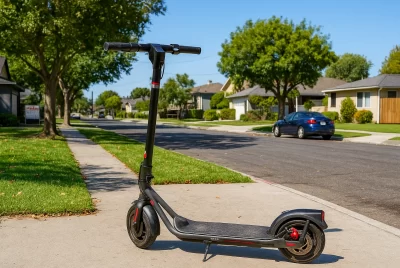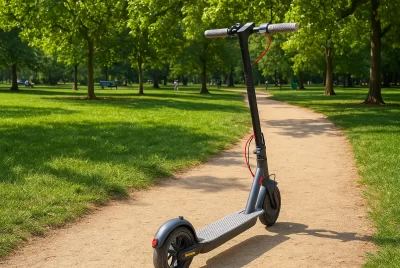Electric Scooter Fire Safety: A Complete Prevention Guide
*We may earn a commission for purchases made using our links. Please see our disclosure to learn more.
Electric scooters have revolutionized urban transportation, offering millions of people an eco-friendly, convenient way to navigate busy streets and crowded cities. These sleek devices promise freedom from traffic jams, reduced carbon footprints, and cost-effective mobility solutions that appeal to commuters, students, and recreational riders alike. However, beneath their modern appeal lies a growing safety concern that demands immediate attention from every owner.
Fire incidents involving electric scooters have increased dramatically as these devices flood the market. Fire departments nationwide report a troubling surge in battery-related fires, with some cities documenting hundreds of incidents annually. The lithium-ion batteries that power these innovative devices, while remarkable in their energy density and efficiency, can transform from reliable power sources into dangerous fire hazards when compromised by damage, improper charging, or manufacturing defects.
The consequences of electric scooter fires extend far beyond property damage. These incidents have resulted in evacuated buildings, displaced families, serious injuries, and even fatalities in extreme cases. Understanding fire risks and implementing comprehensive safety measures has evolved from optional best practices to essential requirements for responsible ownership.
“Lithium-ion battery fires burn extremely hot and fast, reaching temperatures of over 1,000 degrees Fahrenheit and producing toxic gases that can be lethal within minutes.”
– National Fire Protection Association Safety Report
Key Takeaways
- Battery management is critical: Proper charging, storage, and maintenance of lithium-ion batteries significantly reduces fire risk
- Quality matters: Investing in certified scooters and chargers from reputable manufacturers provides essential safety features
- Location awareness: Where you charge and store your scooter can mean the difference between a minor incident and a catastrophic fire
- Early detection saves lives: Understanding warning signs of battery failure allows for immediate action
- Insurance and legal implications: Electric scooter fires can have serious financial and legal consequences
Understanding Electric Scooter Fire Risks
The Science Behind Battery Fires
Electric scooters rely on lithium-ion battery packs that store significant amounts of energy in compact spaces. When these batteries malfunction—a condition known as thermal runaway—they can rapidly overheat, catch fire, and even explode. This process occurs when the battery’s internal temperature rises uncontrollably, causing a chain reaction that releases flammable electrolytes and toxic gases.
The most dangerous aspect of lithium-ion fires is their unpredictability. Unlike traditional fires that build gradually, battery fires can ignite instantly and spread with alarming speed. The toxic smoke produced contains hydrogen fluoride, carbon monoxide, and other deadly gases that can overcome victims before they realize the danger.
Thermal runaway becomes particularly hazardous because it’s self-sustaining. Once the process begins, external cooling or fire suppression often proves ineffective until the battery’s energy is completely exhausted. This characteristic makes prevention far more important than reaction when dealing with electric scooter fire safety.
Common Triggers for Electric Scooter Fires
Several factors can trigger thermal runaway in electric scooter batteries. Physical damage from drops, crashes, or impacts can compromise the battery’s internal structure, creating weak points that lead to failure. Even minor damage that doesn’t immediately affect performance can gradually worsen over time, eventually causing catastrophic failure weeks or months later.
Overcharging represents another significant risk, as continuously supplying power to a fully charged battery generates excess heat that can trigger runaway conditions. Many older scooter models lack sophisticated charging management systems, making them particularly vulnerable to overcharge-related fires.
Manufacturing defects in batteries or charging systems create hidden dangers that may not manifest until months after purchase. These defects can include improper cell assembly, contaminated materials, or faulty protective circuits that fail under stress conditions.
Exposure to extreme temperatures, both hot and cold, can stress battery components and increase fire risk. Leaving scooters in hot cars, direct sunlight, or freezing conditions compromises battery integrity and safety systems. Additionally, using incompatible chargers or damaged charging cables can deliver incorrect voltage or current, damaging the battery’s protective systems.
Water exposure poses a particularly insidious threat, as moisture can corrode internal components and create electrical shorts. Even humidity over time can gradually degrade battery performance and safety features.
Recognizing Warning Signs of Battery Problems
Visual and Physical Indicators
Battery problems often announce themselves through observable changes in the scooter’s appearance and performance. Swelling or bulging of the battery case indicates internal pressure buildup and potential failure. This swelling occurs when gases generated by chemical breakdown accumulate inside the sealed battery housing, creating dangerous pressure that can lead to rupture and fire.
Any visible damage to the battery housing, including cracks, dents, or punctures, creates pathways for moisture and debris that can trigger dangerous reactions. These openings also allow internal gases to escape in uncontrolled ways, potentially creating fire hazards in unexpected locations.
Corrosion around charging ports or battery terminals suggests moisture exposure or chemical leakage. This corrosion typically appears as white, green, or blue-green deposits that can interfere with electrical connections and create resistance that generates dangerous heat buildup.
Discoloration of the battery case, particularly brown or black marks, may indicate previous overheating incidents. These heat signatures suggest the battery has already experienced stress conditions that could lead to future failures.
Performance and Behavioral Changes
Changes in scooter performance often signal developing battery problems before they become visually apparent. Significantly reduced range or rapid power loss during rides indicates battery degradation that could lead to failure. When individual cells within the battery pack begin failing, the remaining cells must work harder to maintain power output, increasing stress and fire risk.
Unusual heat generation during charging or use suggests the battery is working harder than normal, potentially approaching dangerous conditions. Batteries should remain cool to slightly warm during normal operation. Excessive heat indicates internal resistance problems or failing protective systems.
Charging irregularities present clear warning signs that demand immediate attention. Batteries that refuse to charge, charge unusually quickly, or remain warm long after charging completes may have compromised safety systems. Modern battery management systems should regulate charging to prevent overheating and overcharging, so irregularities suggest these crucial safety features may be failing.
Strange odors during charging, particularly sweet, metallic, or chemical smells, indicate electrolyte leakage or internal breakdown. These odors often precede visible smoke or fire by hours or days, providing critical early warning opportunities for prevention.
Safe Charging Practices
Choosing the Right Location
The location where electric scooters charge significantly impacts fire safety outcomes. Ideal charging locations feature hard, non-flammable surfaces away from combustible materials like curtains, furniture, paper products, or stored chemicals. Concrete floors in garages or basements often provide the safest environments, assuming adequate ventilation exists to disperse any gases that might accumulate.
Avoid charging in enclosed spaces without ventilation, such as closets, storage rooms, or sealed garages, where heat and toxic gases can accumulate to dangerous levels. Similarly, charging near exits or escape routes creates evacuation hazards if fires occur, potentially trapping residents or preventing emergency responders from accessing affected areas.
Wooden floors, carpeted areas, and locations near flammable liquids or materials increase both ignition risk and potential damage if fires occur. The radiant heat from battery fires can ignite nearby combustible materials, turning localized battery failures into structure-threatening fires.
Temperature control matters significantly for charging safety. Locations subject to extreme temperatures—whether from direct sunlight, heating systems, or poor insulation—stress battery systems and increase failure risk. Ideal charging temperatures range between 32°F and 95°F (0°C to 35°C), with stable temperatures preferred over fluctuating conditions.
Monitoring and Time Management
Active monitoring during charging prevents many fire incidents from developing into major emergencies. Never leave charging scooters completely unattended, especially overnight or when leaving home for extended periods. Even brief absences during charging can allow dangerous conditions to develop unchecked.
Set timers or phone reminders to check charging progress regularly, looking for signs of overheating, unusual odors, or visible changes in the battery or charging equipment. These regular checks should include visual inspection of the battery case, feeling for excessive heat, and listening for unusual sounds like crackling or hissing.
Most electric scooter batteries require 3-8 hours for complete charging, depending on capacity and charger specifications. Allowing batteries to charge significantly beyond recommended times increases overheating risk and can overwhelm safety systems. Many modern scooters include automatic shutoff features, but these systems can fail or malfunction, making manual monitoring essential.
Storage and Maintenance Guidelines
Optimal Storage Conditions
Proper storage significantly extends battery life while reducing fire risk through environmental control. Store electric scooters in cool, dry locations with stable temperatures between 50°F and 70°F (10°C to 21°C). Basements, garages, and climate-controlled storage areas typically provide ideal conditions, assuming they remain dry and well-ventilated throughout seasonal changes.
Humidity control prevents corrosion and electrical problems that can lead to dangerous failures. Use dehumidifiers in damp areas or silica gel packs near stored scooters to maintain optimal moisture levels below 60% relative humidity. Avoid storing scooters in locations prone to flooding, leaks, or condensation buildup from temperature fluctuations.
Protect stored scooters from physical damage by ensuring adequate clearance around the device and securing them to prevent falls or impacts from other stored items. Even minor impacts during storage can create internal damage that manifests as fire hazards weeks or months later.
Battery Maintenance Protocols
Regular battery maintenance prevents many fire-causing problems through early detection and prevention of deteriorating conditions. Clean battery terminals and charging ports monthly using dry brushes or compressed air to remove debris, dust, and corrosion that can create electrical resistance and heat buildup.
Inspect charging cables regularly for damage, paying particular attention to areas where cables bend or connect to plugs. Replace damaged cables immediately, as compromised insulation or internal wire damage can create dangerous electrical conditions that bypass safety systems.
Maintain optimal battery charge levels during storage periods. Completely drained batteries can develop internal damage through chemical changes, while fully charged batteries under prolonged storage may develop pressure buildup from ongoing chemical reactions. Maintain batteries at 40-60% charge during extended storage periods, checking and adjusting charge levels monthly to prevent deterioration.
Emergency Response and Fire Prevention
Immediate Response Protocols
Knowing how to respond to electric scooter fires can save lives and minimize property damage when prevention efforts fail. If a scooter begins showing signs of thermal runaway—such as swelling, excessive heat, smoke, or unusual odors—immediately disconnect power and move the device away from flammable materials if safely possible without risking personal injury.
Never attempt to extinguish lithium-ion battery fires with water, as this can spread burning electrolytes and create additional electrical hazards. Instead, use Class D fire extinguishers specifically designed for metal fires, or sand to smother flames and contain heat. If specialized extinguishers aren’t available, evacuate immediately and call emergency services rather than attempting improvised suppression methods.
Lithium-ion fires produce toxic gases including hydrogen fluoride, carbon monoxide, and other deadly compounds that can be lethal in enclosed spaces within minutes. Evacuate affected areas immediately, closing doors behind you to contain smoke spread while ensuring your escape route remains clear.
Prevention Through Planning
Develop and practice fire evacuation plans that specifically account for electric scooter locations and potential fire scenarios. Ensure all household members understand warning signs of battery problems and know how to respond safely without putting themselves at risk through heroic but dangerous intervention attempts.
Install smoke detectors near scooter storage and charging areas, testing them monthly and replacing batteries as needed. Consider installing heat detectors as well, since battery fires can generate dangerous conditions before producing significant smoke that triggers standard smoke alarms.
Maintain clear evacuation paths from charging and storage areas at all times. Avoid blocking exits with scooters, equipment, or storage items, and ensure emergency lighting remains functional throughout your home or building to facilitate safe evacuation during power outages or emergency conditions.
Conclusion
Electric scooter fire safety represents a critical responsibility for millions of device owners worldwide. While these innovative mobility solutions offer tremendous benefits for transportation, recreation, and environmental protection, their associated fire risks require serious attention and proactive management throughout the ownership experience.
The key to preventing electric scooter fires lies in understanding the complex risks involved, implementing comprehensive safety practices, and maintaining constant vigilance throughout device ownership. From selecting certified equipment and following proper charging procedures to recognizing warning signs and responding effectively to emergencies, every aspect of electric scooter ownership directly impacts fire safety outcomes.
As electric mobility continues expanding globally, the importance of widespread fire safety education and compliance will only increase. By following established safety guidelines, staying informed about emerging risks and protective technologies, and building safety-conscious communities, electric scooter owners can enjoy their devices’ benefits while minimizing fire risks for themselves and their communities.
The investment in proper safety equipment, procedures, and ongoing education pays significant dividends through reduced risk, lower insurance costs, and invaluable peace of mind. Most importantly, these efforts protect lives and property while supporting the continued growth of sustainable transportation options that benefit everyone.
Frequently Asked Questions
1. How often should I replace my electric scooter battery to prevent fire risks?
Electric scooter batteries typically last 2-4 years or 300-500 charge cycles before showing significant degradation. However, replace batteries immediately if you notice swelling, excessive heat, reduced range, charging problems, or any physical damage. Don’t wait for complete failure, as degraded batteries pose increased fire risks. Monitor battery performance regularly and consult manufacturer guidelines for specific replacement recommendations.
2. Is it safe to charge my electric scooter overnight?
Charging overnight is generally not recommended due to increased fire risks when unattended. If overnight charging becomes necessary, use certified chargers with automatic shutoff features, charge in well-ventilated areas away from flammable materials, and install smoke detectors nearby. Consider smart plugs or timers to limit charging duration, and never charge on beds, couches, or other flammable surfaces.
3. What should I do if my electric scooter battery starts smoking?
If your battery begins smoking, immediately stop using the device and disconnect it from power if safely possible. Move the scooter away from flammable materials and evacuate the area. Do not use water to extinguish lithium-ion fires—use Class D fire extinguishers or sand instead. Call emergency services immediately and remain upwind of toxic fumes. Never attempt to dismantle or handle a smoking battery.
4. Can I use any charger with my electric scooter?
No, always use the charger specifically designed for your scooter model. Generic or universal chargers may appear compatible but can deliver incorrect voltage or amperage, damaging the battery and increasing fire risk. Using incompatible chargers may also void warranties and create liability issues. Purchase replacement chargers only from authorized dealers or manufacturers to ensure proper specifications and safety features.
5. Are there insurance policies that specifically cover electric scooter fires?
Standard homeowner’s or renter’s insurance may not cover electric scooter fire damages, especially if negligence is involved. Some insurance companies now offer specific electric vehicle or personal mobility device coverage that includes fire incidents. Contact your insurance provider to understand current coverage and consider additional policies if needed. Document all safety compliance efforts and equipment certifications to support potential claims.




